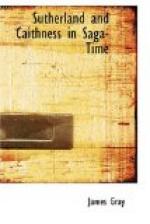The Norse place-names,[6] too, have been faithfully preserved by Gaelic inhabitants, and are still with us; and despite their varying spellings in documents of title and maps of different dates, these names generally yield up the secret of their original meanings when they can be traced back to the earliest charters, especially if they can be compared with the corresponding Gaelic versions of them in use at the present time. For Gaelic was ever a trustworthy vehicle of the original Norse. The Norse place-names too are found in the same spots on which the remains of brochs exist, that is, on the best land at the lowest levels which the Picts had already cultivated, and which the Norse invaders seized. Such names are also found on the eastern coast as far south as Dingwall, both in Ross and Cromarty. They were never imposed on the Moray seaboard, which was not permanently held by the Norse. Freskyn and his descendants saw to that. His fortress at Duffus checked all raids from their fort at Burghead.
Of outward and visible monuments, save here and there a howe or grave-mound, the Vikings, unlike their Pictish predecessors, have left us little or nothing on the mainland. In Iceland the skali[7] or farm-house of the Norseman was built with some stone and turf below, and a superstructure of wood which has long ago perished,[8] and but slight traces of foundations are visible on the surface there. From the frequent burnings in the Saga we know that such houses were of highly inflammable materials which would soon perish. The place-name, “Skaill,” remains both in Sutherland and Caithness. But no skilled antiquary, has as yet laid bare by excavation the secrets of likely sites of Norse dwellings in these counties, as Mr. A.W. Johnston has done at The Jarls’ Bu at Orphir, in Orkney.[9] And yet, if Drumrabyn or Dunrabyn, Rafn’s Ridge or Broch, be the true derivation of Dunrobin (and the name is found at a time when as yet no Robin had inhabited the place) possibly the Norse Lawman Rafn had a house of consequence there like his Pictish predecessors, if, indeed, he did not inhabit the Pictish broch whose foundations were found on or under the present castle’s site. There was also a castle of note on the northern shore of the modern port of Helmsdale, which is probably the castle of Sorlinc of Mr. Collingwood’s William the Wanderer, also called Surclin, both words being a corrupt form, it is suggested, of Scir-Illigh, the old name of the parish of Kildonan.
In Caithness especially, we have many a Norse castle site, such as Earl Harold’s borg at Thurso, and Lambaborg, the modern Freswick, which we know to have been inhabited by noted Norsemen, while, in Sutherland, Borve near Farr, and Seanachaistel on the Farrid Head near Durness seem to be ideal Viking sites. Breithivellir[10] or Brawl Castle was a known residence of Earl John and later earls, and search for foundations might well be made on the coasts of Caithness, and round Tongue and at the mouths of the Naver and of the Borgie and other rivers, and at or near Unes or Little Ferry, possibly at Skelbo, (Skail-bo) and in Kildonan at Helmsdale. That the Norsemen used many of the Pictish brochs as dwelling-places is more than probable, and is proved by the Sagas in certain instances.[11] At the same time few articles used distinctively by Norsemen have been found in them.




